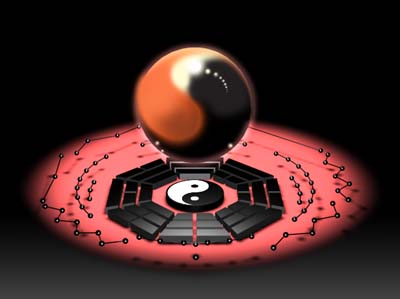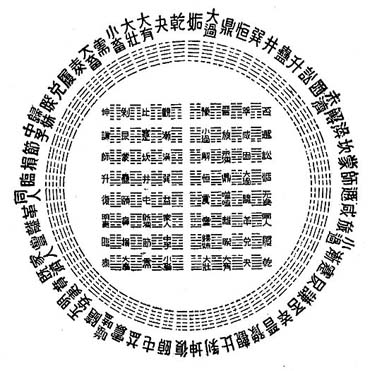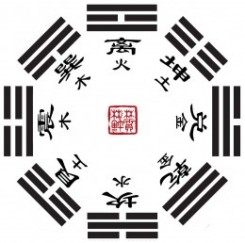I-Ching 易经 – Background
“I-Ching”, pronounces as “yi-jing” is also known as “The Book of Changes”. It is the oldest known text referring to prediction, universal energy and the balance between positive and negative forces.
“Yi Jing” (I-Ching) has been derived into a set of symbols that classify different level of changes. From basic environment to characteristic of living things, to atmospheric weather and characteristic motion of living things etc… The combinations of different I-Ching symbols became a method of accurate prediction. I-Ching survived for over 3500 years in Chinese culture it even influence some of the major religions such as Buddhism, Christian, Hinduism etc…
I-Ching uses two main symbols consists of a continuous line known as the “Yang Stoke __ ” or “Positive Stoke” and a broken line known as the “Yin Stroke – -” or the “Negative Stroke”. This is similar to the I and O binary in modern day computer language.
Yin & Yang of Life 易经与人
In Prof Lei Xu’s Bayesian Yin Yang and Harmony Learning Paper. It sparked a thought of the relation of Yin Yang and mankind. Under this study, it shows that a person is born with innate abilities and emotions that has some form of energy related to the environment. This controls a person’s experiences in all form of changes in a life time. The following displays the various contents of basic I-Ching symbols.
I-Ching, it begins with 2 strokes, then develops into the 4 climatic forces, further develops into the 8-trigrams that becomes the fundamental energy of all living forces.
易经: 太极生两仪,两仪生四象,四象生八卦,八卦演万物。
两仪: 阴爻、阳爻 2 strokes are the positive and negative strokes.
四象: 太阳、太阴、少阳、少阴 The 4 climatic forces are the major and minor positives and the major and minor negatives.
They develop into the 8-trigrams or in Chinese term known as The Ba-Gua consists of Qian, Kan, Gen, Zheng, Xun, li, Kun, Dui as the Earthy Ba-Gua 乾,兑,离,震,巽,坎,艮,坤(后天八卦)and the second combination consists of Qian, Dui, Li, Zheng, Xun, Kan, Gen, Kun as the Heavenly Ba-Gua. 八卦: 乾,坎,艮,震,巽,离,坤,兑(先天八卦)
The 8-Trigrams that relate to the atmospheric and earth forms.
- 乾 Qian – 天 Tian (Heaven)
- 兑 Dui – 泽 Zhe (Lake)
- 离 Li – 火 Huo (Fire)
- 震 Zhen – 雷 Lei (Thunder)
- 巽 Xun – 风 Feng (Wind)
- 坎 Kan – 水 Shui (Water)
- 艮 Gen – 山 Shan (Mountain/Hill)
- 坤 Kun – 地 Di (Earth)
The 8-trigrams further develop into 64 with 384 strokes.
Wu Ji 无极 and Tai-Ji 太极
It all begins from “Total Emptiness” known as “Wu-ji 无极” and derived to “Tai ji 太极” which is the basis of positive (Yang 阳) represented by the white shade area and the negative (Yin 阴) is a solid black area. Ancient scholars believed that everything is formed by positive and negative forces or some form of energy. This is the basis of the ON and OFF, darkness and brightness, the Sun and Moon, Day and Night, Male and Female etc… The co-existence of the polarities to form balance within the Tai-Ji theory.
Yin and Yang are basically the changes within the 64 Gua or referred to as the “Trigrams”. In the 64 Gua 卦, each Gua is made up of 6 lines making it a Hexagram. The lines in a Gua is known as a yao 爻. The yao 爻 consists of both yin 阴 strokes and yang 阳 strokes.
The 64 gua shown below has each its own term of reference and each with its own combination with different meanings. For detail explanations of each gua can be found in my book ” The Feng Shui Story”.
先天八卦
Combination of 64 Guas 六十四卦
- 乾为天 乾上乾下 Tian, 天风姤 乾上巽下 Gou,
- 天山遯 乾上艮下 Dun, 天地否 乾上坤下 Bi, 风地观 巽上坤下 Guan,
- 山地剥 艮上坤下 Bo, 火地晋 离上坤下 Jin, 火天大有 离上乾下 Da-You,
- 坎为水 坎上坎下 Shui, 水泽节 坎上兑下 Jie,
- 水雷屯 坎上震下 Jun, 水火即济 坎上离下 Ji Ji, 泽火革 兑上离下 Ke,
- 雷火丰 震上离下 Feng, 地火明夷 坤上离下 Ming-yi, 地水师 坤下坎上 Shi,
- 艮为山 艮上艮下 Shan, 火山贲 离上艮下 Bi,
- 山天大畜 艮上乾下 Da-Chu, 山泽损 艮上兑下 Sun, 火泽睽 离上兑下 Kui,
- 天泽履 乾上兑下 lv, 风泽中孚 巽上兑下 Zhong-fu, 风山渐 巽上艮下 Jian,
- 震为雷 震上震下 Zheng, 雷地豫 震上坤下 Yu,
- 雷水解 震上坎下 Xie, 雷风恒 震上巽下 Heng, 地风升 坤上巽下 Sheng,
- 水风井 坎上巽下 Jing, 泽风大过 兑上巽下 Da Guo, 泽雷随 兑上震下 Sui
- 巽为风 巽上巽下 Feng, 风天小畜 巽上乾下 Xiao-chu
- 风火家人 巽上离下 Jia-ren, 风雷益 巽上震下 Yi, 天雷无妄 乾上震下 Wu-wang,
- 火雷噬嗑 离上震下 Shi-he, 山雷颐 艮上震下 Yu, 山风蛊 艮上巽下 Gu
- 离为火 离上离下 Li, 火山旅 离上艮下 Lv
- 火风鼎 离上巽下 Ding, 火水未济 离上坎下 Wei-ji, 山水蒙 艮上坎下 Meng,
- 风水涣 巽上坎下 Huang, 天水讼 乾上巽下 Song, 天火同人 乾上离下 Tong-ren
- 坤为地 坤上坤下 Di, 地雷復 坤上震下 Fu
- 地泽临 坤上兑下 Lin, 地天泰 坤上乾下 Tai, 雷天大壮 震上乾下 Da-zhuang,
- 泽天夬 兑上乾下 Guai, 水天需 坎上乾下 Xu, 水地比 坎上坤下 Bi
- 兑为泽 兑上兑下 Ze, 泽水困 兑上坎下 Kun
- 泽地萃 兑上坤下 Cui, 泽山咸 兑上艮下 Xian, 水山蹇 坎上艮下 Jian,
- 地山谦 坤上艮下 Qian, 雷山小过 震上艮下 Xiao-guo, 雷泽归妹 震上兑下 Gui-mei





